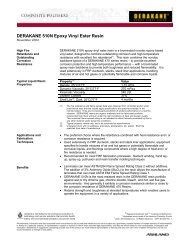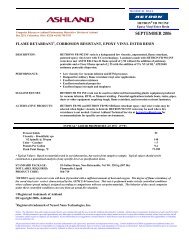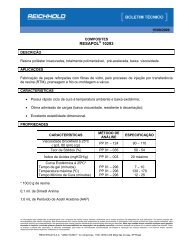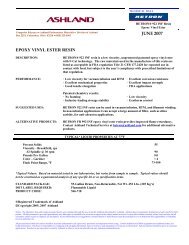Hetron-Ashland Resins
Hetron-Ashland Resins
Hetron-Ashland Resins
Create successful ePaper yourself
Turn your PDF publications into a flip-book with our unique Google optimized e-Paper software.
ELECTRICAL PROPERTIES<br />
The cured resins have high dielectric constants and low<br />
dissipation factors. Dielectric constant is the ratio of<br />
the capacitance of a weakly conducting material to<br />
that of air. Dissipation factor is the loss of energy resulting<br />
when a polymeric material experiences molecular<br />
motion in an alternating electric field. See Table 6 for<br />
electrical properties of standard resin castings.<br />
TABLE 6<br />
ELECTRICAL PROPERTIES OF CLEAR CASTINGS<br />
(TYPICAL VALUES PER ASTM D150)<br />
Average<br />
Dielectric Dissipation dielectric<br />
Resin constant1 factor constant2 HETRON 942/35 3.45 0.0050 3.38<br />
HETRON 922 3.34 0.0123 3.39<br />
HETRON FR992 3.29 0.0128 3.21<br />
HETRON 980 3.44 0.0055 3.34<br />
HETRON 197-3 3.04 0.0156 2.94<br />
AROPOL 7334 3.49 0.0106 3.37<br />
HETRON 800 5.35 0.0253 4.94<br />
HETRON 92FR 3.37 0.0201 3.27<br />
HETRON 99P 3.39 - 3.28<br />
HETRON 700 2.94 0.0147 2.88<br />
1 = KHz 2 = Average of 1KHz 10KHz 100KHz and 1MHz<br />
10<br />
FLAME RESISTANCE<br />
Many HETRON polyester and epoxy vinyl ester resins<br />
are based on halogenated intermediates. These unique<br />
chemical structures account for their excellent corrosion<br />
resistance and also make these HETRON resin<br />
composites inherently flame resistant. For increased<br />
flame resistance, antimony oxide can be added to<br />
many of these resins during fabrication. Antimony<br />
oxide is not effective when added to non-halogenated<br />
resins. ASTM E84 “Standard Method of Test for Surface<br />
Burning Characteristics of Building Materials’’ is<br />
commonly referred to as the “Tunnel Test.’’ This tunnel<br />
test is the accepted standard for determining flame<br />
spread values.<br />
Current industry practice requires materials of<br />
construction for ducts, hoods, and other fume handling<br />
equipment to have a flame spread rating of 25 or less<br />
(commonly referred to as Class I). See Table 7 for<br />
specific flame spread values.<br />
Several other tests commonly used for classifying<br />
smoke and flame retardant properties of FRP equipment<br />
include ASTM E162 “Standard Test Method for<br />
Surface Flammability of Materials Using a Radiant<br />
Heat Energy Source (Radiant Panel Test),’’ ASTM E662<br />
“Standard Test Method for Specific Optical Density<br />
of Smoke Generated by Solid Materials (Smoke<br />
Chamber),’’ UL94 “Standard for Tests for Flammability<br />
of Plastic Materials for Parts in Devices and<br />
Appliances.’’<br />
For more specific information on these and other<br />
flame resistance test results (UL94, oxygen index, cone<br />
calorimeter), contact your sales or technical service<br />
representative. Please consult HETRON Technical<br />
Service for low smoke alternatives.<br />
TABLE 7<br />
FLAME SPREAD VALUES OF COMPOSITES1 (TYPICAL VALUES PER ASTM E84)<br />
Resin type Flame spread Class2 CONTROL:<br />
Asbestos/Cement<br />
0 I<br />
HETRON FR998/35<br />
(no antimony trioxide required)<br />


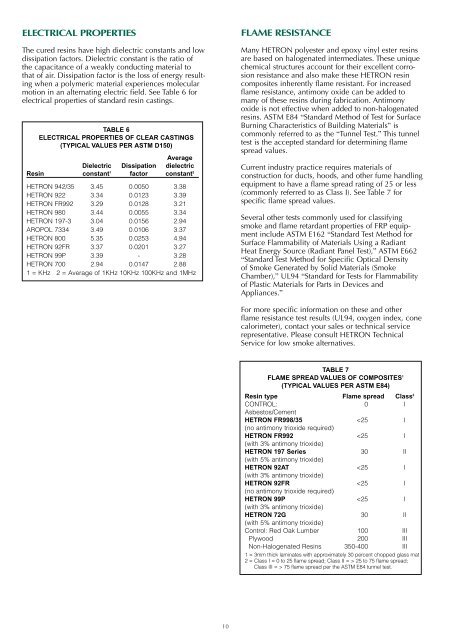
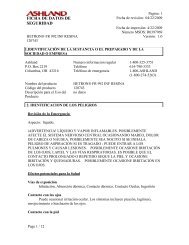
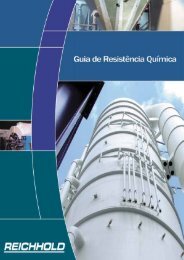
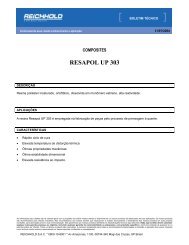




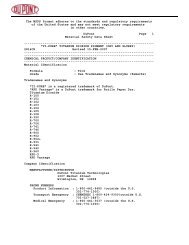
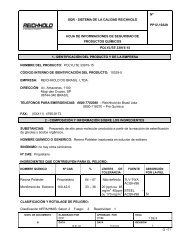
![[ES] - LUPEROX K10 - 2008-04-02](https://img.yumpu.com/40905446/1/184x260/es-luperox-k10-2008-04-02.jpg?quality=85)
